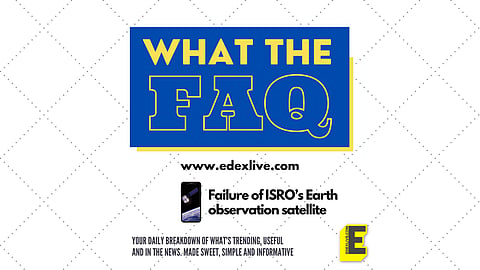

It was supposed to be India's eye-in-the-sky, a state-of-the-art agile Earth Observation Satellite with a mission life that was supposed to be ten years long. After a normal take-off on the morning of August 12, 2021, things took a U-turn for the Indian Space Research Organization's (ISRO) EOS-03. All of a sudden, the mission was aborted.
Soon, a national-level Failure Analysis Committee (FAC) was formed to investigate what exactly went wrong with EOS-03 and they finally submitted their report on Friday, March 25. In this edition of What The FAQ, let's look at what the report says and how India missed out on this golden opportunity.
What is EOS-03?
Earth Observation Satellite or EOS-03 with 2280W power was launched by India’s Geosynchronous Satellite Launch Vehicle-F10 (GSLV-F10) from Satish Dhawan Space Centre (SDSC) SHAR, Sriharikota. GSLV-F10 was to place the satellite in the Geosynchronous Transfer Orbit so that it could help with four objectives:
- At regular intervals, provide real-time imaging of areas of interest
- Monitor natural disasters and such
- Obtain spectral signatures for disaster management or observing water bodies, forests, agriculture and so on
- Monitor cyclones, cloud bursts, thunderstorms and more
Then what happened on August 12, 2021?
After a smooth countdown of 26 hours, the mission lifted off as it ought to have at 5:43 am on August 21, 2021. It was also observed that the performance of the first stage (GS1), the strap-on stages (L40) and the second stage (GS2) were all satisfactory and were in adherence to pre-flight predictions. But 4:09 minutes after the lift-off, "a deviation in performance of the Cryogenic Upper Stage (CUS)” happened. It is noteworthy that this is the very last stage of the rocket which is fueled by cryogenic engines. These engines utilise liquid oxygen and liquid hydrogen to provide the thrust that the rocket needs to lift off the ground. Thus, at 5:11 minutes, the onboard computer aborted the mission.
What was the Failure Analysis Committee (FAC) required to do?
The FAC, constituted by experts from the field of academia and ISRO, analysed everything from the preparation to launch off. It also reviewed flight data and lift-off conditions.
What was the conclusion it arrived at?
The committee observed that post the lift-off, when the Cryogenic Upper Stage engine was fired up, there was a build-up of pressure in the propellant (Liquid Hydrogen or LH2) tank which was noted as an anomaly. This led to lower tank pressure which eventually led to the failure of the mission.
What do the previous studies say about it?
Previous studies imply that this could have happened because of a leak in the Vent and Relief Valve (VRV), this is usually utilised for relieving the build-up of excess tank pressure during flight. The most probable reason behind this leakage could be that during valve operations the soft seal could have been damaged or due to contamination. It could have also been due to "valve mounting stresses induced under cryogenic temperature conditions," the report stated.
What does the failure of this mission mean for India?
Not only was EOS-03 supposed to remain in orbit for ten years but because of the failure, the launch of the next such satellite, EOS-04, has been pushed.
